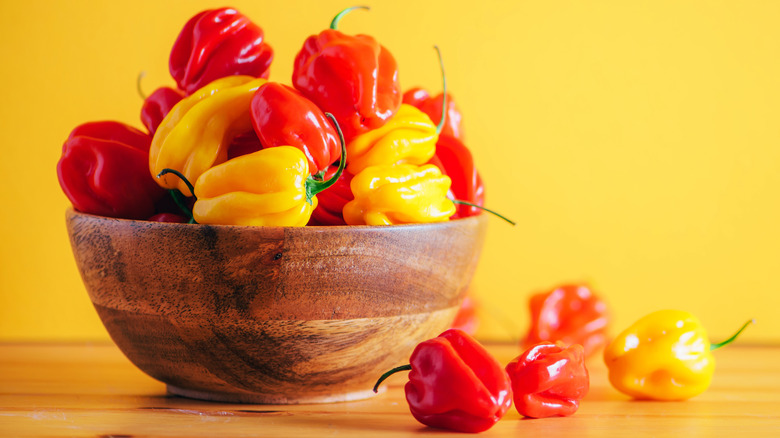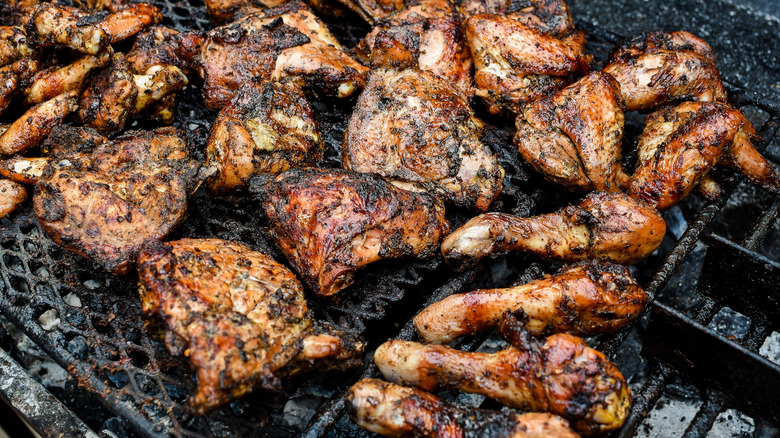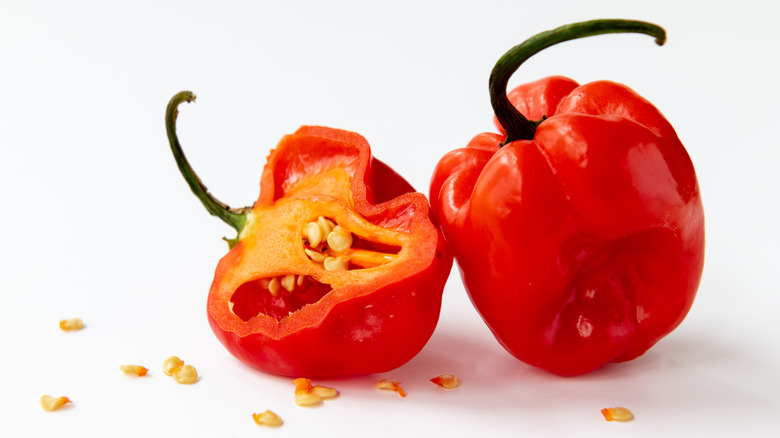The Best Way To Use The Fiery Scotch Bonnet Chile Pepper
Clocking in at roughly 100,000 to 350,000 Scoville heat units, the Scotch bonnet chile is about as spicy as a habanero. However, this colorful pepper delivers a lot more than heat alone. It possesses a remarkably fruity taste, noticeably sweeter than that of a habanero, and a bright citrus kick that together give it a more complex and well-balanced flavor profile than just about any other chile out there. It's quite versatile to work with (provided you enjoy the burn), being a great addition to marinades, salsas, soups, curries, and even pickles or infused vinegars. However, if you want to use the Scotch bonnet chile to its full potential, look to Jamaica, where it rules local cuisine.
Yes, it turns out "Scotch bonnet" is a bit of a misnomer, as the chiles are certainly not from cold, foggy highlands. These peppers are in fact named for their resemblance to the Scottish hat known as a tam-o'-shanter. Scotch Bonnets originated in the Amazon basin but were brought to the Caribbean by the indigenous Taino people beginning around A.D. 650.
The Taino cultivated chiles throughout much of the Caribbean, particularly the island they dubbed Xaymaca ("land of wood and water"), which we now know as Jamaica. There, they helped birth a culinary style that centered partially on the Scotch bonnet pepper: jerk. By marrying the fiery pepper with the flavors of allspice and thyme, jerk seasoning adds a flavorful kick to grilled foods. It's most notably used for chicken, but you don't have to stop there.
How jerk was developed
The tradition of jerk cooking rose from tragic circumstances to become a cultural icon. The violence and disease brought by Spanish colonists nearly wiped out the Taino population, leaving only small enclaves alive. Europeans had come to rely on enslaved Indigenous people for labor, so enslaved Africans were brought in to replace them, and this continued when Jamaica was later taken over by the British in 1655. Some enslaved Africans managed to escape captivity, becoming known as Maroons, and in some cases, they ended up intermarrying with the surviving Taino.
From the union of these two groups came jerk cooking, with the word "jerk" stemming from the Spanish "charqui," meaning dried meat (think jerky). Originally, the Taino and the Maroons developed jerk cooking partially to avoid enslavement. It's traditionally done in an underground pit, because above-ground cooking let off smoke that could give away their location to colonizers.
The method of cooking may have been the most critical part of jerk cuisine at first, but the term has now come to be best associated with a certain type of seasoning. Initially, the jerk marinade was used for purposes of preservation as well as flavor, helping the Maroons and Taino get the most out of their meat. Jerk is built around the three core ingredients of allspice, thyme, and Scotch bonnet chiles, rounded out by other herbs and spices, both fresh and dried, as well as heaps of garlic. You can put it on chicken, pork, or vegetables. Check out this jerk seasoning recipe and try making your own.
Other ways to cook with Scotch bonnets
Jerk seasoning is, in many people's eyes, the culinary signature of Jamaica, and certainly something you need to try if you can. But the flavors of jerk — allspice, thyme, and particularly the Scotch bonnet — make their presence known in other dishes throughout the island and beyond. The best way to use Scotch bonnets outside of jerk seasoning just might be in Jamaican pepper sauce, a fiery mixture of peppers and vinegar that often incorporates allspice as well as cho-cho, aka chayote, a type of squash popular in South America and the Caribbean. Pepper sauce can be used like a condiment or as a marinade in its own right, perfect for chicken, pork, and fish.
Scotch bonnet chiles can also be used for various sauces, spice rubs, and garnishes, but there is one downside to this delightful pepper. Outside of Jamaica, Scotch bonnets are overshadowed by other, more famous and widely available chiles such as the habanero and jalapeño, which can make it a bit challenging to find them, depending on where you live. They also tend to be more expensive than their better-known counterparts, which is why it's all the more important that you use them to their full potential.


